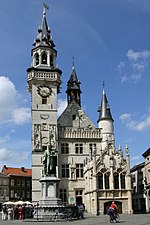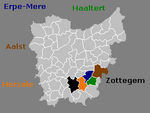Groot Park

The Groot park or Park schepen de Wolf or city park of Aalst (stadspark) is a park in the Belgian city of Aalst. It can be regarded as an artificial nature domain with a recreational-educational function. The park covers an area of approximately 15 hectares (37 acres). The city park is located south of the city center. It is bordered by the Parklaan, Désiré De Wolfstraat and Erembodegemstraat. The park is protected by the Flanders Heritage Agency.It is located between the urban sports fields and the industrial zone on the Dender. In the south, the park flows into the Osbroek nature reserve, which covers almost 25 hectares (62 acres). The park is 800 meters away from De grote markt of Aalst.The park was built in 1915 and the construction was a way to give jobless people a job. In the park there's the Melkhuisje (milk-house), a restaurant that is open since 1916, originally selling milk, now a restaurant. Since 2023 they're searching for a new owner of het Melkhuisje, it's future is therefore uncertain.
Excerpt from the Wikipedia article Groot Park (License: CC BY-SA 3.0, Authors, Images).Groot Park
Erembodegemstraat,
Geographical coordinates (GPS) Address Nearby Places Show on map
Geographical coordinates (GPS)
| Latitude | Longitude |
|---|---|
| N 50.93032 ° | E 4.046294 ° |
Address
Erembodegemstraat 1
9300 (Aalst)
East Flanders, Belgium
Open on Google Maps










